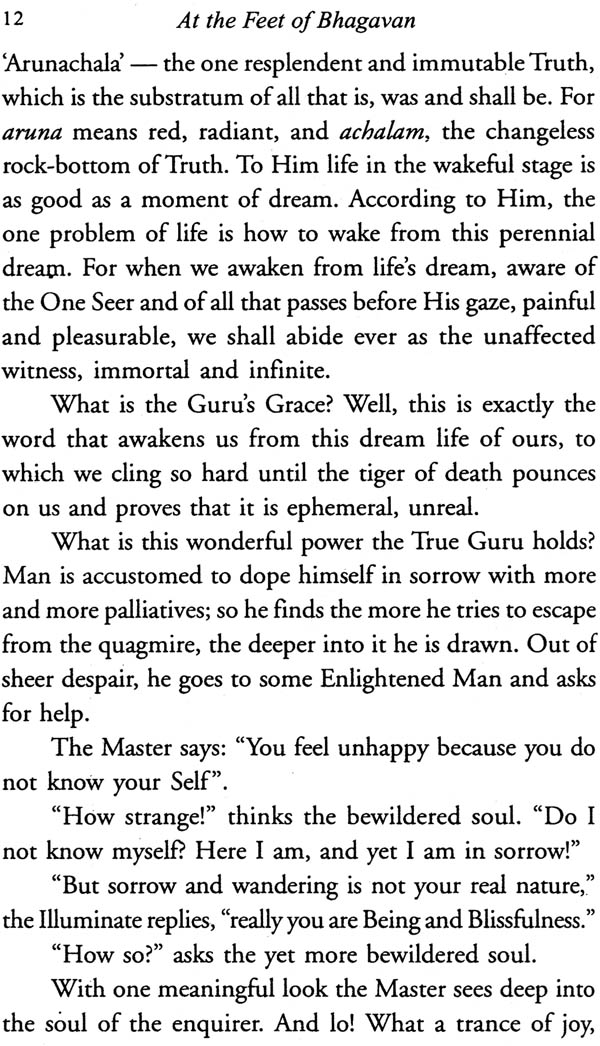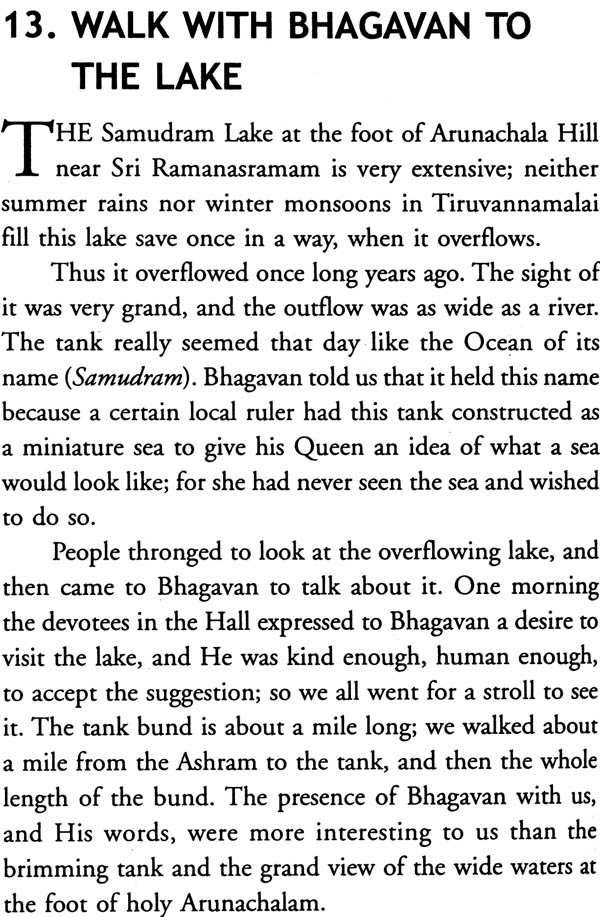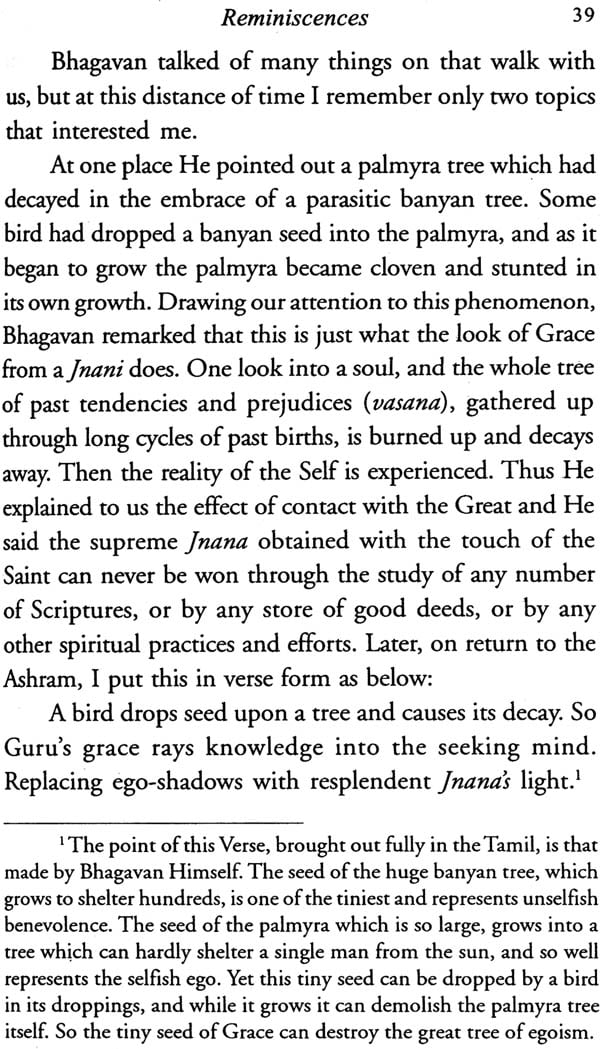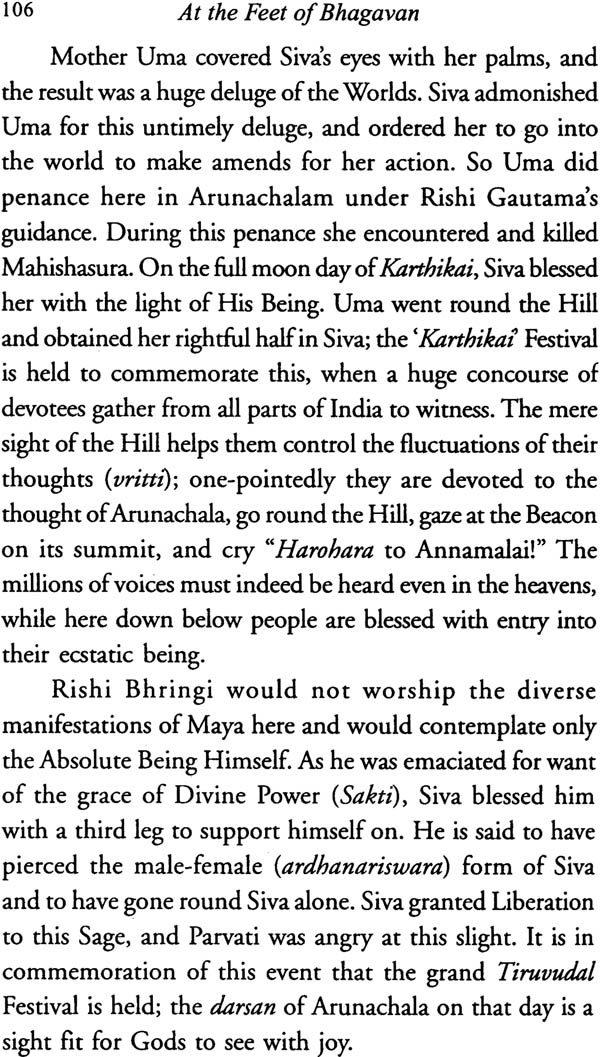
At the Feet of Bhagavan
Book Specification
| Item Code: | NAF562 |
| Author: | T.K.Sundaresa Iyer |
| Publisher: | Sri Ramanasramam, Tamil Nadu |
| Language: | English |
| Edition: | 2017 |
| ISBN: | 8188018953 |
| Pages: | 120 |
| Cover: | Paperback |
| Other Details | 8.5 inch X 5.5 inch |
| Weight | 170 gm |
Book Description
Bhagavan Sri Ramana Maharshi’s life itself is Upadesa. His every moment was Upadesa. His every action, his every movement was the eternal Upadesa – the Golden Silence. Though His Written teachings are themselves standing monuments of Truth, yet for those who could not have direct access to His Teachings through the privilege of living with the Master – what is the next best resource.
The seeker if sincere and earnest to tread the direct path of Vichara as taught by Sri Ramana, will find it easier to attach himself to the older devotees who have lived with the Master and directly imbibed his words of nectar. Thus the writings and reminiscences of older devotees of Sri Bhagavan assume great importance.
Precious indeed are the records left by those to whom the Master showed his Grace. Fortunately for us, such sincere devotees have come forward to share that experiences with their Master, by putting them down in words.
T.K. Sundaresa Iyer’s life itself is a dedication to the spiritual quest ans as such, is worth emulating by earnest seekers. He paid his first visit to Sri Bhagavan in 1908. Although materially poor, Sundaresa Iyer had ample spiritual wealth, which he shared with fellow devotees, devoting much of his time in service to the Ashram.
He has helped many seekers in clarifying the path of Ramana. By odd circumstances the manuscript of this book, which was so well edited by no less a scholar devotee than Duncan Greenlees, as far back as December 1962, was lost in the Ashram Archives. Now it is available to every one of us.
Sri Bhagavan, while defining what Upadesa is, says: “Upadesa means showing a distant object quite near. Brahman (God), which the disciple believes to be distant and different from himself, is near and not different from himself.
Bhagavan Sri Ramana Maharshi’s life itself is Upadesa. His every action, His every movement was the eternal Upadesa — the Golden Silence. Though His written teachings are themselves standing monuments of Truth, yet, for those who could not have direct access to His teachings through the privilege of living with the Master — what is the next best recourse?
The seeker if sincere and earnest to tread the direct path of Vichara as taught by Sri Ramana, will find it easier to attach himself to the older devotees who have lived with the Master and directly imbibed His words of nectar. Thus the writings and reminiscences of older devotees of Sri Bhagavan assume great importance.
Precious indeed are the records left by those to whom the Master showed His Grace. Fortunately for us, such sincere devotees have come forward to share their experiences with their Master, by putting them down in words. Posterity owes a deep debt to the blessed memory of these old devotees.
It is my proud privilege to write about my teacher, Sri T.K. Sundaresa Iyer. He was not only a bhakta of the highest order but also an erudite scholar, though he did not possess any academic qualifications. His knowledge of English, Sanskrit and of course Tamil, was vast and deep. Added to these, Sri T.K.S., as he was addressed affectionately by all, acted as an interpreter to English- speaking visitors in their conversations with Sri Bhagavan. He also replied to correspondence received by the Ashram on spiritual matters, consulting Sri Bhagavan every time he had to reply to specific spiritual questions. Thus he acquired a full and comprehensive knowledge of Sri Bhagavan’s teachings which have been incorporated in this book. His reminiscences of the Master portray the beauty, tenderness and compassion of Sri Bhagavan’s personality. The narration of Sri Bhagavan taking care of the cracked egg is, perhaps, the standing example for this. His language is simple but in content its richness does not lag behind any similar spiritual literature.
Sri T.K.S .‘s life itself is a dedication to the spiritual quest and as such, is worth emulating by earnest seekers. He paid his first visit to Sri Bhagavan in 1 O8. Having once seen Him, he became His ardent devotee. He was also one of those captivated by the magnetic personality of Sri Kavyakantha Ganapati Muni. When the Muni 1 for Belgaum in 1926 he remained in Tiruvannamalai practically made the Ashram his home. Although materially poor, Sri Sundaresa Iyer had ample spiritual wealth, which he shared with fellow-devotees, devoting much of his time in service to the Ashram. For quite before his death he remained permanently in the Ashram precincts, as a living example of humility and devotion. In February of 1965, after being a close devotee of Sri Bhagavan for nearly fifty years, at the age of 68, he passed away peacefully, conscious to the very end, Sri Ramana Nagar, thus ending a lifetime with Bhagavan.
He has helped many seekers, including myself, in clarifying the path of Ramana. There are still many who would unhesitatingly express their deep debt to Sri T.K.S. fro their spiritual maturity. I can, without hesitation, affirm that he was not only a Rishi in appearance but also in experience.
By odd circumstances the manuscript of this book, which was so well edited but no less a scholar-devotee than Mr. Duncan, as far back as December 1962, was lost in the Ashram archives. It was brought to light recently, thanks to Sri Jim Grant and Sri David Godman, who are doing yeoman service by classifying the Ashram archives and rearranging the whole Ashram Library.
Now it is available to every one of us. I treat this as an act of Sri Bhagavan’s Grace ! I request fellow-devotees and earnest seekers to posses this book and thereby benefit themselves spiritually.
| Part One: Guru's Grace | ||
| 1 | Introduction - 'A lifetime with Bhagavan' | 3 |
| 2 | The Maharshi's Greatness | 10 |
| 3 | A Voice from the Hill of the Holy Beacon | 11 |
| Part Two: Reminiscences | ||
| 4 | Sri Ramana Gives Rama darshan | 17 |
| 5 | Initiation for Sri Bhagavan ? | 22 |
| 6 | Deepavali Darshan | 24 |
| 7 | Introduction to the Collected Works | 26 |
| 8 | Bhagavan tells of Kannappar the Saint | 28 |
| 9 | The Teaching in Silence | 32 |
| 10 | Can a cracked egg be hatched? | 33 |
| 11 | Does it not pain the tree ? | 36 |
| 12 | He was my remembrancer | 37 |
| 13 | Walk with Bhagavan to the lake | 38 |
| 14 | The Pontiff and Sri Bhagavan | 42 |
| 15 | Thoughts Travels too | 45 |
| 16 | That Hoomkar | 47 |
| 17 | Proxy Cure at a Distance | 50 |
| 18 | The Ekarat and the Princely Beggar | 52 |
| 19 | I am not talking to you ! | 54 |
| 20 | In Brute and Man alike | 55 |
| 21 | "Who am I, Nayana ? | 57 |
| 22 | Bhagavan as a Classical Sanskrit Poet | 58 |
| 23 | How the Mantra came | 61 |
| 24 | Envoi | 63 |
| Part Three: The Guru's Teaching | ||
| 25 | The Essence of the Teaching | 67 |
| 26 | What does the Guru Say? | 68 |
| 27 | The Knower and the Magician | 71 |
| 28 | How the "Five Hymns to Arunachala" came | 75 |
| 29 | Where is the Divine World? | 82 |
| 30 | Who am I? | 84 |
| 31 | Where can the Self be bound? | 86 |
| 32 | Silence, self-imposed or imposed by the Self? | 87 |
| 33 | The Divine Ruler | 90 |
| 34 | The Ribhu Gita | 92 |
| 35 | Questions and Answers | 98 |
| Part Four: Appendix | ||
| 36 | Tiruvannamalai-Arunachalam | 105 |
| 37 | My Little Ones | 110 |
| 38 | Six Verses in praise of Sri Bhagavan | 111 |













